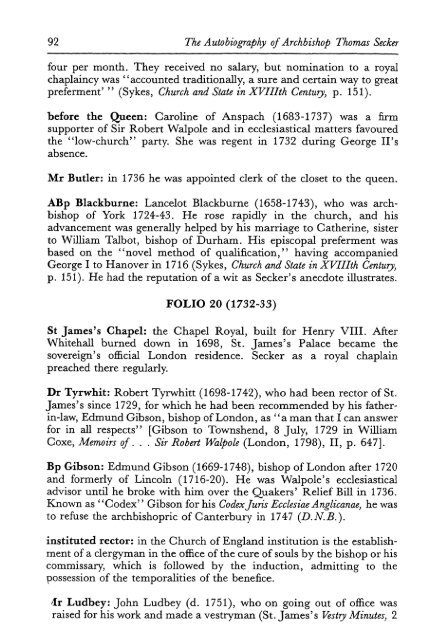Archbishop of Canterbury - KU ScholarWorks - The University of ...
Archbishop of Canterbury - KU ScholarWorks - The University of ...
Archbishop of Canterbury - KU ScholarWorks - The University of ...
You also want an ePaper? Increase the reach of your titles
YUMPU automatically turns print PDFs into web optimized ePapers that Google loves.
92 <strong>The</strong> Autobiography <strong>of</strong> <strong>Archbishop</strong> Thomas Seeker<br />
four per month. <strong>The</strong>y received no salary, but nomination to a royal<br />
chaplaincy was "accounted traditionally, a sure and certain way to great<br />
preferment' " (Sykes, Church and State in XVIIIth Century, p. 151).<br />
before the Queen: Caroline <strong>of</strong> Anspach (1683-1737) was a firm<br />
supporter <strong>of</strong> Sir Robert Walpole and in ecclesiastical matters favoured<br />
the "low-church" party. She was regent in 1732 during George IFs<br />
absence.<br />
Mr Butler: in 1736 he was appointed clerk <strong>of</strong> the closet to the queen.<br />
ABp Blackburne: Lancelot Blackburne (1658-1743), who was archbishop<br />
<strong>of</strong> York 1724-43. He rose rapidly in the church, and his<br />
advancement was generally helped by his marriage to Catherine, sister<br />
to William Talbot, bishop <strong>of</strong> Durham. His episcopal preferment was<br />
based on the "novel method <strong>of</strong> qualification," having accompanied<br />
George I to Hanover in 1716 (Sykes, Church and State in XVIIIth Century,<br />
p. 151). He had the reputation <strong>of</strong> a wit as Seeker's anecdote illustrates.<br />
FOLIO 20 (1732-33)<br />
St James's Chapel: the Chapel Royal, built for Henry VIII. After<br />
Whitehall burned down in 1698, St. James's Palace became the<br />
sovereign's <strong>of</strong>ficial London residence. Seeker as a royal chaplain<br />
preached there regularly.<br />
Dr Tyrwhit: Robert Tyrwhitt (1698-1742), who had been rector <strong>of</strong> St.<br />
James's since 1729, for which he had been recommended by his fatherin-law,<br />
Edmund Gibson, bishop <strong>of</strong> London, as "a man that I can answer<br />
for in all respects" [Gibson to Townshend, 8 July, 1729 in William<br />
Coxe, Memoirs <strong>of</strong>. . . Sir Robert Walpole (London, 1798), II, p. 647].<br />
Bp Gibson: Edmund Gibson (1669-1748), bishop <strong>of</strong> London after 1720<br />
and formerly <strong>of</strong> Lincoln (1716-20). He was Walpole's ecclesiastical<br />
advisor until he broke with him over the Quakers' Relief Bill in 1736.<br />
Known as "Codex" Gibson for his Codex Juris Ecclesiae Anglicanae, he was<br />
to refuse the archbishopric <strong>of</strong> <strong>Canterbury</strong> in 1747 (D.N.B.).<br />
instituted rector: in the Church <strong>of</strong> England institution is the establishment<br />
<strong>of</strong> a clergyman in the <strong>of</strong>fice <strong>of</strong> the cure <strong>of</strong> souls by the bishop or his<br />
commissary, which is followed by the induction, admitting to the<br />
possession <strong>of</strong> the temporalities <strong>of</strong> the benefice.<br />
Ax Ludbey: John Ludbey (d. 1751), who on going out <strong>of</strong> <strong>of</strong>fice was<br />
raised for his work and made a vestryman (St. James's Vestry Minutes, 2

















